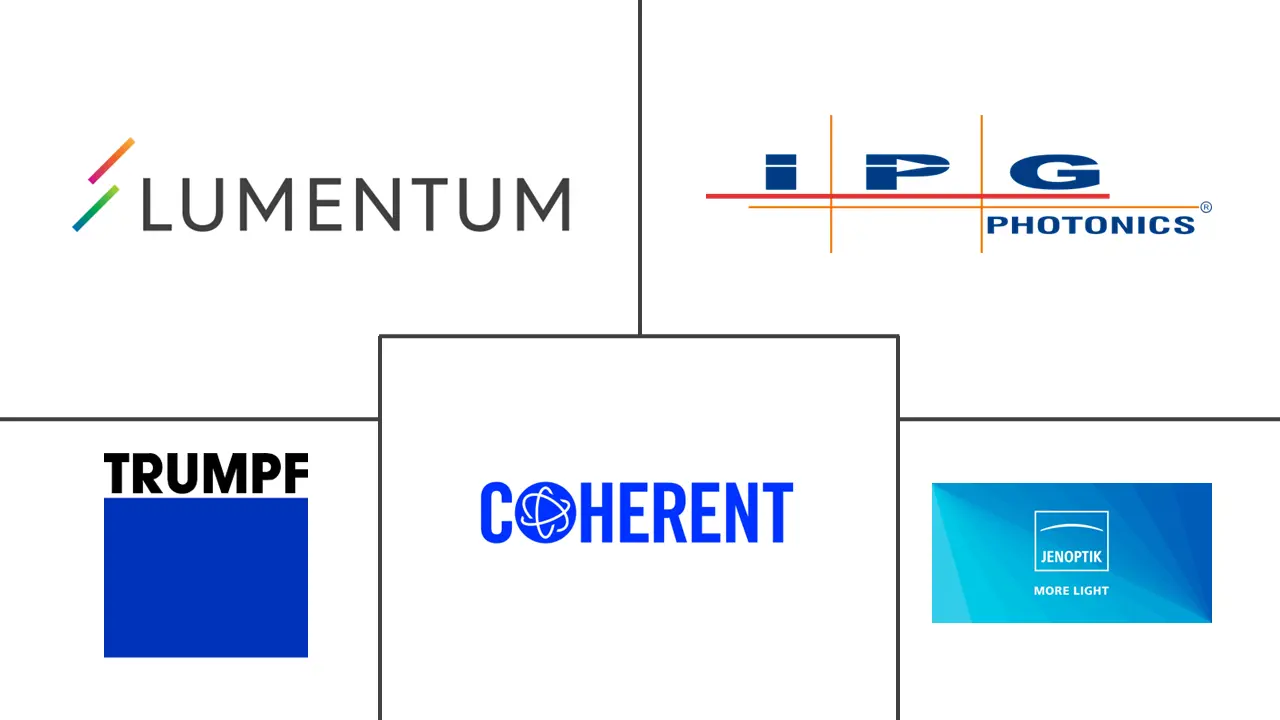Laser Processing Market Size and Share
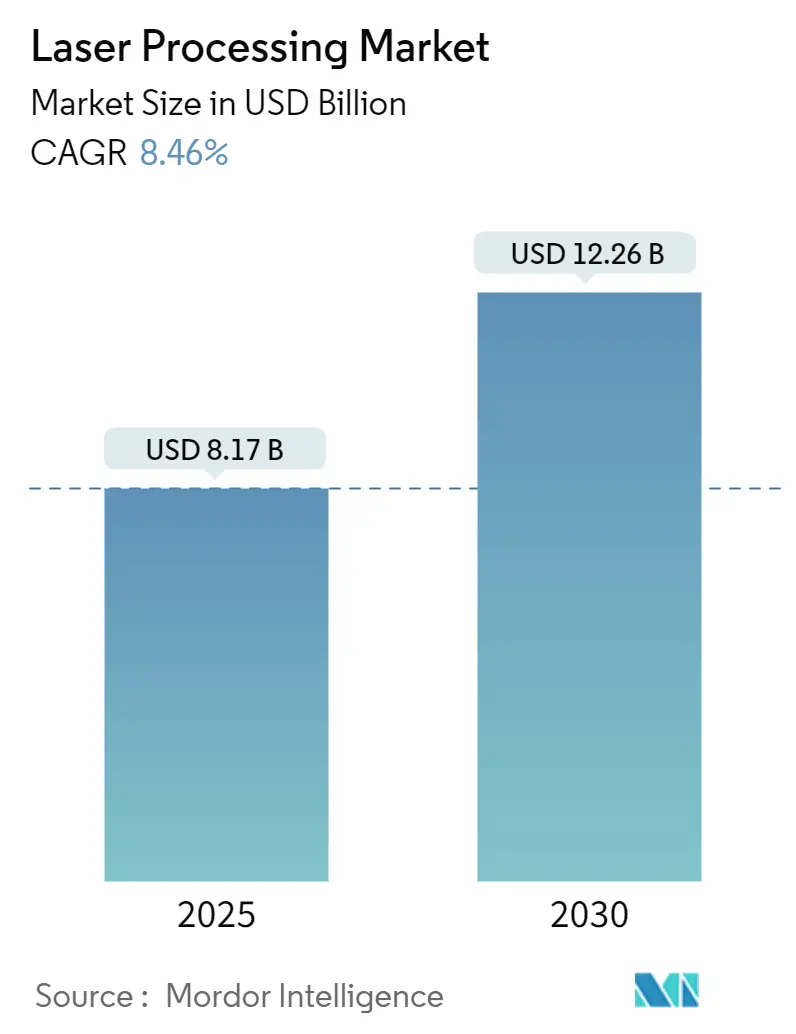
Laser Processing Market Analysis by Mordor Intelligence
The laser processing market generated USD 8.17 billion in 2025 and is forecast to reach USD 12.26 billion by 2030, reflecting an 8.46% CAGR. Growth stems from sustained electrification in transportation, semiconductor capacity additions, and manufacturers’ preference for non-contact, high-precision processing over traditional tooling. Asia-Pacific leads demand as Chinese solar-cell makers expand laser scribing lines, and Japanese and Taiwanese chip fabs add ultrafast laser equipment to support sub-10 nm nodes.[1]Taipei Representative Office in Singapore, “Taiwan and the Global Semiconductor Supply Chain,” roc-taiwan.orgFiber-laser systems remain the workhorse for high-volume metalworking because they cut energy use roughly 50% versus legacy CO₂ platforms. Meanwhile, ultrafast sources gain traction in medical devices and semiconductor via drilling, driving double-digit growth. Electric-vehicle battery welding, Industry 4.0 retrofits in Europe, and additive-manufacturing build-rate improvements open new revenue streams, although helium scarcity and photonics-talent gaps temper expansion.[2]U.S. Geological Survey, “Mineral Commodity Summaries 2024,” pubs.usgs.gov
Key Report Takeaways
- By laser type - Fiber lasers held 48% of laser processing market share in 2024; ultrafast lasers are projected to grow at a 10.7% CAGR to 2030.
- By process type - Cutting dominated with 35.2% revenue in 2024; marking & engraving is forecast to expand at a 9.2% CAGR through 2030.
- By configuration - Moving-beam systems led with 61% of the laser processing market share in 2024; hybrid configurations are set for a 9.4% CAGR to 2030.
- By application - Material macro-processing captured 55% of laser processing market size in 2024, while additive manufacturing is advancing at a 10.2% CAGR to 2030.
- By end-use industry - Automotive accounted for 28.5% revenue in 2024; medical devices and healthcare are pacing the field with an 11.4% CAGR to 2030.
- By geography - Asia-Pacific commanded 46.9% of 2024 revenue; the Middle East & Africa region shows the fastest trajectory at 9.1% CAGR through 2030.
Global Laser Processing Market Trends and Insights
Drivers Impact Analysis
| Driver | ( ~ ) % Impact on CAGR Forecast | Geographic Relevance | Impact Timeline |
|---|---|---|---|
| Electrification-driven EV battery welding demand | +1.8% | Europe, North America, expanding to APAC | Medium term (2-4 years) |
| Government incentives for semiconductor fabs | +1.5% | East Asia core, spill-over to North America | Long term (≥ 4 years) |
| Ultrafast lasers for minimally-invasive devices | +1.2% | North America, expanding to Europe | Medium term (2-4 years) |
| Industry 4.0 laser-cutting retrofits in SMEs | +0.9% | Germany, broader EU hubs | Short term (≤ 2 years) |
| High-volume solar-cell laser scribing | +1.4% | China core, Southeast Asia | Long term (≥ 4 years) |
| Directed-energy defense R&D programs | +0.8% | United States, allied markets | Long term (≥ 4 years) |
| Source: Mordor Intelligence | |||
Electrification-driven EV Battery Welding Demand in Europe
Surging European EV output is raising demand for precision copper busbar welds, a task fiber lasers complete with less heat input than resistance methods. Coherent’s ARM FL platform achieves 7 mm weld depths with minimal porosity, supporting weight-saving battery designs.[3]Coherent, “Deep Copper Laser Welding: Helping to Carry the Loads of Our Electrified Future,” coherent.com European gigafactories report that lasers now handle about 60% of cell-assembly joins, 40% above conventional automotive lines. IPG Photonics’ dual-beam heads further shorten quality-control cycles by measuring weld integrity in real time. The move from aluminum to copper conductors reinforces laser adoption because copper’s high conductivity challenges traditional techniques.
Government Incentives for Semiconductor Fab Lasers in East Asia
Japan’s METI has earmarked JPY 70.5 billion (USD 470.3 million) for SiC power-semiconductor lines that depend on laser annealing and wafer dicing. Parallel subsidies under the U.S. CHIPS and Science Act spur tool suppliers to localize ultrafast-laser production capacity, nudging the U.S. share of global wafer output toward 14% by 2032. Every public dollar pulls in around three dollars of private laser-tool investment, accelerating adoption in advanced-packaging nodes that require femtosecond drilling.
Integration of Ultrafast Lasers for Minimally-Invasive Medical Devices in North America
FDA clearances for 1,726 nm acne treatments and cataract-surgery systems validate clinical efficacy and drive hospital demand.[4]American Society for Laser Medicine and Surgery, “State-of-the-Art Laser Treatment Provides a Safe, Effective, Reproducible, and Durable Treatment of Acne,” aslms.org Alcon’s USD 356 million purchase of LENSAR underscores strategic interest in femtosecond platforms. Pairing ultrafast sources with AI enables adaptive tissue targeting that trims procedure times by up to 30% while improving outcomes. North American OEMs increasingly embed femtosecond units in stent-cutting and implant texturing lines, reinforcing regional technology leadership.
Industry 4.0 Retro-fits Elevating Laser-Cutting Adoption in German SMEs
Labor shortages and mass-customization trends motivate German SMEs to swap mechanical tooling for connected laser cutters. TRUMPF’s TruLaser 1000 Lean Edition lowers entry costs and simplifies controls, easing skills constraints. Embedded AI from SiMa.ai delivers in-process quality checks that reduce scrap and downtime. Government digitalization grants support retrofits where break-even volumes have fallen below 50 pieces for complex parts, making lasers economical for small batch sizes. The EU-funded FLASH program aims to commercialize energy-efficient, customizable laser cells by 2026.
Restraints Impact Analysis
| Restraint | % Impact on CAGR Forecast | Geographic Relevance | Impact Timeline |
|---|---|---|---|
| Shortage of Skilled Photonics Workforce in the Nordics | -0.8% | Nordic countries, expanding to broader Europe | Medium term (2-4 years) |
| Helium Supply Volatility Raising CO₂ Laser Opex Globally | -0.6% | Global, particularly affecting industrial CO₂ laser users | Short term (≤ 2 years) |
| IP-linked Import Restrictions on Laser Tools in India | -0.4% | India, with potential spillover to other emerging markets | Medium term (2-4 years) |
| EU-MDR Stringency Delaying Laser-based Medical Device Launches | -0.5% | European Union, affecting global medical device manufacturers | Long term (≥ 4 years) |
| Source: Mordor Intelligence | |||
Shortage of Skilled Photonics Workforce in the Nordics
Nordic optics firms struggle to fill laser-technician roles as only 300 U.S. community-college graduates emerge annually for 800 openings worldwide. EU surveys show 86% of photonics companies are SMEs that lack resources to train talent. Wages topping USD 100,000 fail to close the gap, prompting production delays and relocation of expansion plans. Regional initiatives such as LASER-TEC increase scholarships, yet the pipeline remains below AIM Photonics’ forecast need of 3,500 new workers per year.
Helium Supply Volatility Raising CO₂ Laser Opex Globally
Grade-A helium sales totaled 79 million m³ in 2023, but reserve closures and geopolitical export bans have tightened supply and tripled prices since 2022. CO₂ laser shops that rely on helium assist gas face surging operating costs, driving some to accelerate fiber-laser upgrades despite the required capex. Research into atmospheric extraction is under way, yet commercial viability lags net-zero timelines. Users that cannot justify equipment swaps incur margin pressure, limiting new CO₂ laser installations.
Segment Analysis
By Laser Type: Fiber Dominance Drives Ultrafast Innovation
Fiber lasers generated the largest slice of the laser processing market in 2024 at 48% on the strength of their compact architecture and lower maintenance. Superior wall-plug efficiencies cut plant energy bills, widening total-cost-of-ownership advantages over CO₂ units. Ultrafast femtosecond and picosecond sources grow the fastest at 10.7% CAGR as chipmakers and medical OEMs demand sub-micron accuracy for via drilling and stent cutting. Solid-state platforms such as disk and Nd:YAG lasers remain viable for specialty wavelengths in aerospace. CO₂ machines keep a foothold in thick-sheet fabrication, yet helium pricing erodes their competitiveness. Diode lasers capture niche medical-aesthetic tasks, while excimer units stay indispensable for lithography.
The emergence of AI-enabled control loops allows a single controller to optimize pulse width, frequency, and power on-the-fly across differing materials. TRUMPF’s SiMa.ai collaboration illustrates this convergence, delivering real-time weld-quality analytics to boost uptime. Academic labs have even achieved 1%-layer removal accuracy on diamond, heralding atomic-scale machining. Such milestones underpin incremental upgrades that preserve installed-base compatibility while stretching performance envelopes.
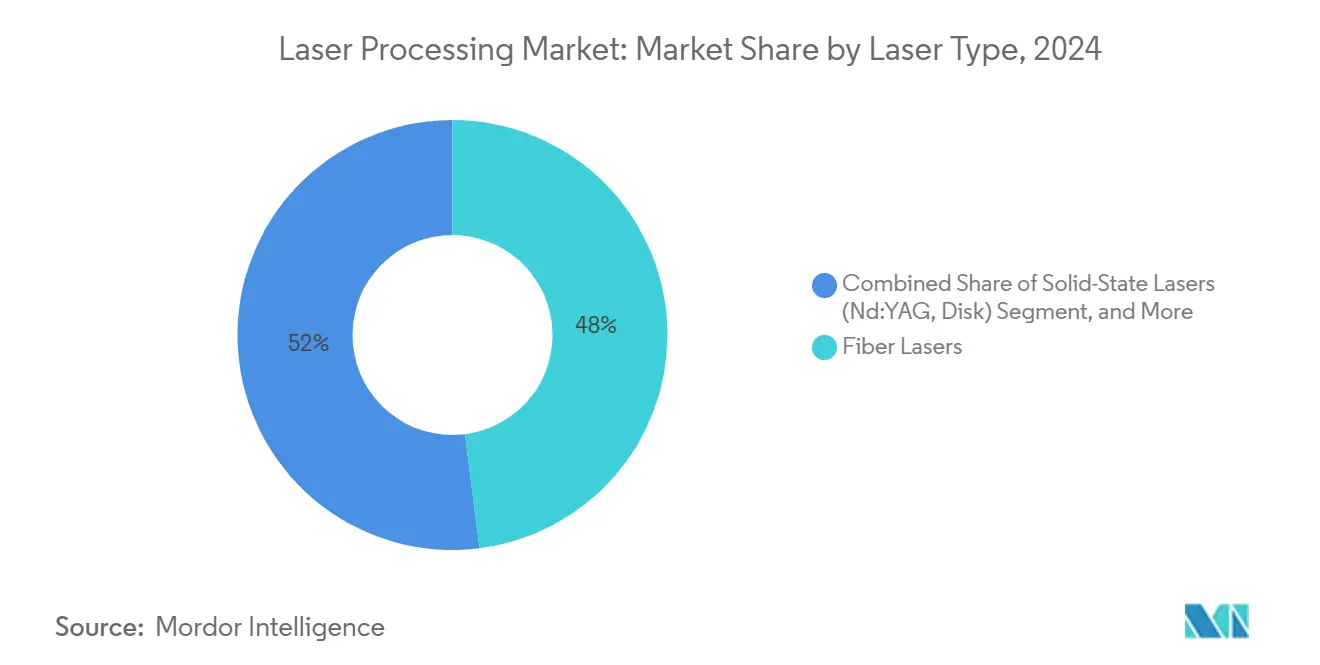
Note: Segment shares of all individual segments available upon report purchase
By Process Type: Cutting Applications Lead Manufacturing Transformation
Cutting held 35.2% of 2024 revenue, confirming its status as the workhorse application for the laser processing market. EV battery enclosures, aerospace skins, and structural beams rely on laser cut tolerances of ±0.1 mm at high feed rates. Marking and engraving record the fastest 9.2% CAGR as traceability mandates grow in medical implants and auto electronics. Machine-vision cameras linked to AI classifiers verify codes in real time, slashing defect rates by 90% relative to inkjet.
Laser welding adoption accelerates alongside EV output because dual-beam heads join dissimilar metals without filler. Fincantieri’s trials showed dynamic-beam welding sliced cycle times 40% and energy use 60%. Drilling and surface-treatment niches expand steadily in turbine components. Additive manufacturing rides powder-bed build-rate leaps beyond 324 cm³/h, enhancing economics for Ti-6Al-4V implants. Collectively, these advances reinforce lasers’ role as a flexible toolkit underpinning smart-factory initiatives.
By Configuration: Moving Beam Systems Enable Manufacturing Flexibility
Moving-beam machines captured 61% of laser processing market size in 2024 thanks to gantry and robotic arms able to process varied shapes without fixture swaps. Automakers favor these systems for body-in-white parts, maximizing line throughput. Hybrid configurations grow 9.4% per year by fusing scanning heads with multi-axis stages to switch between macro and micro work on one asset. Beam-shaping optics re-chevron energy profiles mid-process, optimizing holes, channels, and cuts with minimal downtime.
Fixed-beam cells still serve high-volume identical parts where capital efficiency outweighs flexibility, such as smartphone frames. Nevertheless, breakthrough glass-interposer etching that replaces silicon substrates in advanced packaging relies on ultra-short-pulse hybrid machines from TRUMPF and SCHMID, cutting cost and cycle time for chipmakers. Remote monitoring modules feed edge-AI algorithms that predict drift, enabling 25% lower downtime relative to legacy platforms.
By Application: Material Processing Dominance Faces Additive Manufacturing Challenge
Material macro-processing accounted for 55% of 2024 revenue as cutting, welding, and surface hardening remain fundamental to automotive and aerospace supply chains. However, additive manufacturing tops growth at 10.2% CAGR as aerospace primes shift to qualified laser powder-bed fusion for lightweight, topology-optimized parts. The latest dual-beam fiber lasers push 99.9% density in Ti-6Al-4V at record build rates, widening the addressable output window.
Micro-machining thrives where electronics miniaturization demands micron-scale vias. Surface treatments evolve from hardening toward functional texturing that improves osseointegration in implants. Medical and aesthetic procedures accelerate with 1,726 nm platforms offering selective sebaceous-gland ablation. Scientific research and telecom photonic links sustain niche demand for exotic-wavelength lasers. These diverse paths collectively reinforce the laser processing market’s resilience to sector swings.
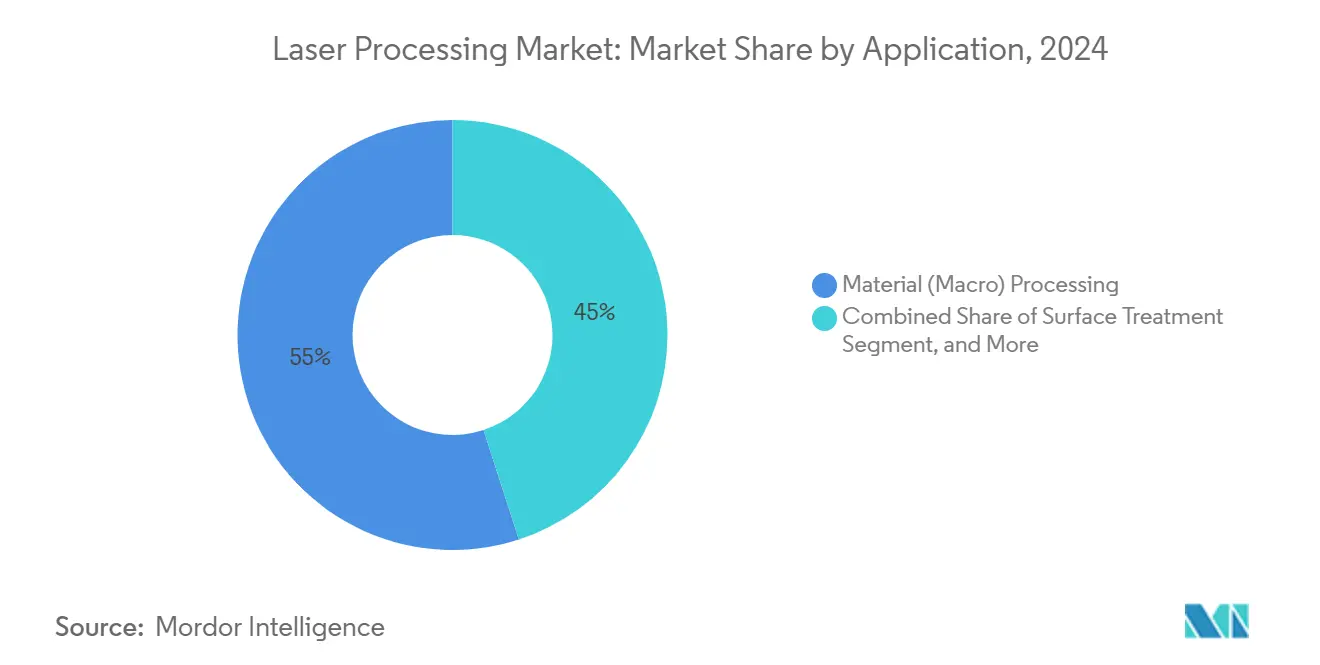
Note: Segment shares of all individual segments available upon report purchase
By End-Use Industry: Automotive Leadership Faces Medical Device Growth
Automotive retained the largest share at 28.5% in 2024 as battery casings, motor laminations, and body panels migrate to laser welding and cutting for weight reduction. Copper busbar joining underscores lasers’ ability to tackle high-conductivity metals that frustrate resistance welding. Medical devices, growing at 11.4% CAGR, benefit from femtosecond texturing that promotes biocompatibility and from cataract-surgery systems that raise surgical precision.
Aerospace and defense spending on directed-energy R&D and turbine drilling sustains high-power-laser demand. Electronics manufacturers leverage lasers for dicing and packaging as governments onshore chip capacity. Solar-PV lines in China rely on high-throughput laser scribing to raise cell efficiency. These cross-sector drivers broaden the customer base and buffer macro-economic shocks.
Geography Analysis
Asia-Pacific dominated with 46.9% of 2024 revenue, buoyed by China’s solar-module factories that control 99% of crystalline-silicon output and specify high-speed laser scribers. Japanese subsidies totaling JPY 3.9 trillion aim to triple domestic chip sales by 2030, further stimulating laser-tool imports. Taiwan’s TSMC is expanding Japan operations, enhancing regional supply-chain resilience. South Korea invests in memory and OLED lines that rely on ultrafast laser patterning, while Southeast Asia attracts electronics assemblers seeking cost diversification.
Europe ranks second, anchored by German Industry 4.0 programs that help SMEs retrofit laser cutters. EV battery gigafactories from Sweden to Spain integrate fiber-laser welding as standard equipment. Nonetheless, 80% of EU photonics firms report supply bottlenecks tied to overseas component sourcing. The FLASH consortium’s goal of customizable laser cells by 2026 supports regional sovereignty. Nordic countries lag due to technician shortages, restraining plant expansions despite strong order books.
North America excels in high-value medical, aerospace, and defense applications. CHIPS Act incentives worth USD 52.7 billion enlarge domestic fab capacity, driving orders for wafer-dicing femtosecond platforms. The Pentagon’s USD 789.7 million FY 2025 budget for directed-energy weapons secures a pipeline for high-power fiber sources. Additive-manufacturing pilots backed by NASA and OEMs raise demand for multi-kilowatt lasers with closed-loop monitoring.
Latin America grows steadily on industrial diversification, whereas the Middle East & Africa region, though small, records the fastest 9.1% CAGR as Gulf infrastructure projects and Turkish defense programs adopt laser-based cutting and welding lines. African telecom rollouts require fiber-optic components that benefit from laser micromachining, adding incremental volume.
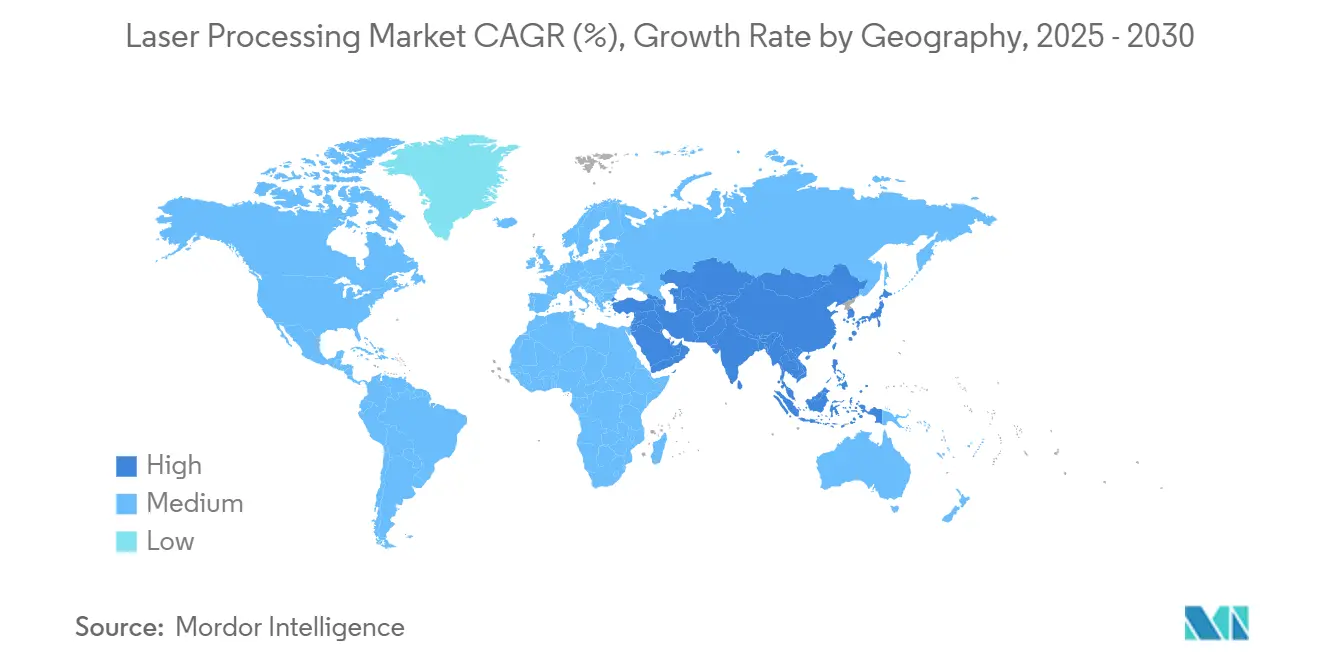
Competitive Landscape
The laser processing market is moderately consolidated, with TRUMPF, IPG Photonics, and Coherent Corp. leveraging broad portfolios and service networks to defend share. IPG’s USD 30 million purchase of cleanLASER strengthens its surface-treatment range. Alcon’s USD 356 million acquisition of LENSAR highlights health-care players’ intent to secure proprietary femtosecond technology. TRUMPF partners with SiMa.ai to embed edge-AI in laser controllers, narrowing the gap between machine tools and smart-factory standards.
Coherent’s backlog of USD 2.6 billion illustrates persistent demand for customized systems, particularly in EUV lithography subsystems and EV battery welding. Niche entrants concentrate on application-specific gaps: Halo Industries raised USD 80 million to scale laser-based SiC wafer slicing that promises lower kerf-loss than diamond saws. Sumitomo Heavy Industries’ purchase of LASSE gives it laser annealers for SiC power devices, aligning with the EV drivetrain boom.
Competition is increasingly data-centric. Vendors bundle process-monitoring sensors, predictive-maintenance analytics, and cyber-secure remote support to lower customers’ lifetime costs. Service contracts and subscription firmware upgrades become recurring-revenue levers. At the same time, helium-price shocks push CO₂ users toward fiber upgrades, presenting capture opportunities for suppliers that offer financing and retrofit kits.
Laser Processing Industry Leaders
-
TRUMPF Group
-
Coherent Corp.
-
IPG Photonics Corporation
-
Lumentum Holdings Inc.
-
Jenoptik AG
- *Disclaimer: Major Players sorted in no particular order
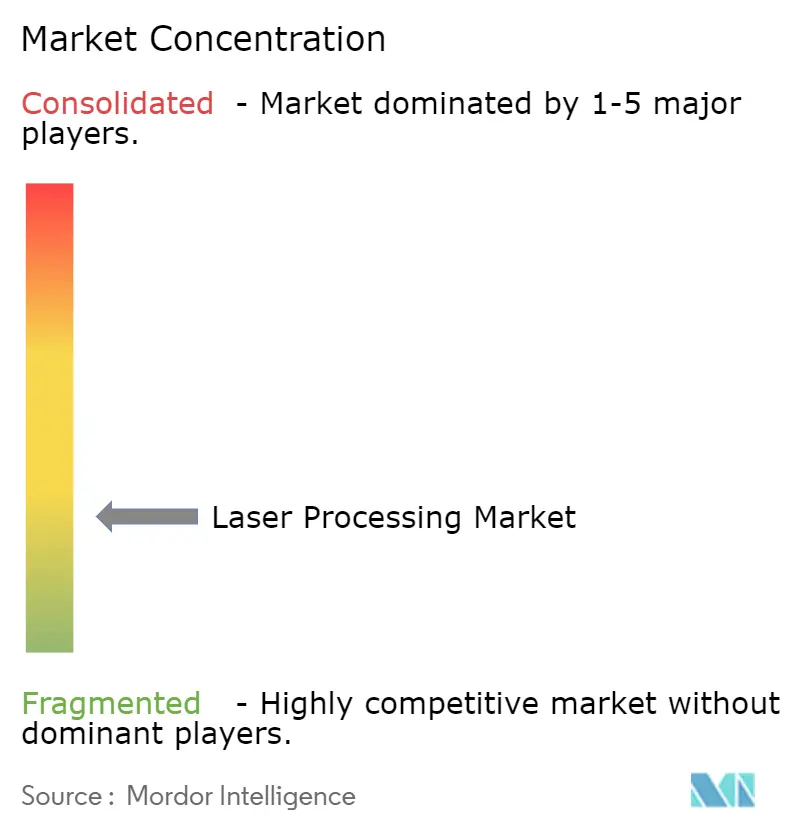
Recent Industry Developments
- March 2025: Alcon agreed to acquire LENSAR for USD 356 million, adding the ALLY robotic cataract laser system to its ophthalmic-surgery portfolio.
- February 2025: Coherent launched FACTOR Series fiber-coupled diode pumps delivering up to 220 W for medical and industrial lasers.
- January 2025: TRUMPF and SCHMID unveiled a combined laser-etch process that enables glass interposers for chip packaging.
- January 2025: IPG Photonics introduced the 2 kW LightWELD 2000 XR handheld welding and cleaning system, offering 4× TIG speed.
- January 2025: Thorlabs acquired Praevium Research to deepen capabilities in tunable VCSELs for OCT and machine-vision markets.
Research Methodology Framework and Report Scope
Market Definitions and Key Coverage
Our study defines the laser processing market as the sale of equipment and integrated systems that employ focused laser beams to cut, weld, drill, mark, engrave, surface-treat, or additively build metallic and non-metallic materials across manufacturing, electronics, medical-device, energy, and transportation sectors. These values are expressed in USD revenue generated from new machines and retrofit modules delivered through OEM and system integrator channels.
Scope Exclusions: Stand-alone photonic communication lasers, aesthetic beauty devices, and purely research laboratory sources are not counted.
Segmentation Overview
- By Laser Type
- CO? Lasers
- Fiber Lasers
- Solid-State Lasers (Nd:YAG, Disk)
- Ultrafast (Femtosecond/Picosecond)
- Diode Lasers
- Excimer Lasers
- Other Laser Types
- By Process Type
- Cutting
- Welding (incl. Hybrid, Remote)
- Marking and Engraving
- Drilling
- Surface Treatment/Hardening
- Micro-Machining
- Additive Manufacturing (DMLS, LMD)
- Other Processes
- By Configuration
- Fixed Beam
- Moving Beam
- Hybrid Beam
- By Application
- Material (Macro) Processing
- Micro-Machining
- Surface Treatment
- Additive Manufacturing
- Medical and Aesthetic Procedures
- Scientific Research and Photonic Communications
- Other Applications
- By End-Use Industry
- Automotive
- Electric-Vehicle Battery Manufacturing
- Aerospace and Defense
- Electronics and Semiconductor
- Medical Devices and Healthcare
- Energy and Solar Photovoltaic
- Industrial Machinery
- Packaging
- Jewelry and Luxury Goods
- Research Institutes and Universities
- Other Industries
- By Geography
- North America
- United States
- Canada
- Mexico
- Europe
- Germany
- United Kingdom
- France
- Italy
- Rest of Europe
- Asia-Pacific
- China
- Japan
- South Korea
- India
- South East Asia
- Rest of Asia-Pacific
- South America
- Brazil
- Rest of South America
- Middle East and Africa
- Middle East
- Africa
- North America
Detailed Research Methodology and Data Validation
Primary Research
Engineers at automotive body-in-white shops, semiconductor line managers, contract medical device manufacturers, and Asian job-shop owners share run-rate throughput, typical beam power, and average selling prices. These conversations help us sanity-check secondary ratios, fine-tune regional penetration rates, and sense near-term order pipelines that might not yet appear in public filings.
Desk Research
Mordor analysts begin with production, trade, and usage indicators from open datasets such as UN Comtrade shipment codes for machine tools, OECD industrial production indices, OICA vehicle output, and the Laser Institute of America's safety bulletin counts. Supplemental context comes from company 10-Ks, patent families mapped through Questel, and news archives on Dow Jones Factiva that flag capacity additions or line conversions. We also reference D&B Hoovers for revenue splits of leading system builders and Marklines when the equipment is destined for automotive stamping plants. This list is illustrative rather than exhaustive; many additional sources inform validation.
Market-Sizing & Forecasting
A top-down construct translates industrial production dollars into potential laser system demand using penetration multipliers by vertical, which are then corroborated through bottom-up spot checks of supplier shipments and sampled ASP × volume math. Variables that sway the model include average sheet-metal thickness processed, fiber-laser cost erosion per watt, EV battery welding station uptake, factory automation investment cycles, export share of capital goods, and regional labor cost differentials. A multivariate regression with lagged macro indicators and ASP learning curves projects revenue through 2030, while scenario analysis gauges upside from additive manufacturing acceleration. Gaps in bottom-up evidence are bridged with regional analogs adjusted for wage and energy cost variance.
Data Validation & Update Cycle
Modeled outputs pass variance checks against historical import bills and quarterly earnings. Senior reviewers challenge any swing greater than three percentage points, and fresh desk plus call-backs are triggered if anomalies persist. Reports refresh yearly, with mid-cycle edits for material events, ensuring clients receive the most current baseline.
Why Mordor's Laser Processing Baseline Earns Industry Trust
Published estimates diverge because firms pick different boundaries, currencies, and refresh cadences, and because laser sources, systems, and services often blur in public disclosures.
Key gap drivers include whether sources bundle laser diodes and photonics modules, how aggressively they roll forward ASP deflation, and if refurbishments are double-counted. Mordor chooses a machine-only scope, ties ASP trends to verified purchase orders, and revisits every assumption each year.
Benchmark comparison
| Market Size | Anonymized source | Primary gap driver |
|---|---|---|
| USD 8.17 B (2025) | Mordor Intelligence | |
| USD 7.17 B (2025) | Global Consultancy A | Excludes additive manufacturing tools and several emerging economies |
| USD 23.70 B (2024) | Trade Journal B | Adds laser sources and service contracts, uses list prices without regional weighting |
These comparisons show that figures swing widely when scope widens or unchecked price lists inflate revenue. By anchoring definitions tightly, validating with field data, and revisiting variables annually, Mordor Intelligence delivers a balanced baseline clients can rely on.
Key Questions Answered in the Report
What is the current value of the laser processing market?
The laser processing market is valued at USD 8.17 billion in 2025 and is projected to reach USD 12.26 billion by 2030.
Which laser type holds the largest share?
Fiber lasers lead with 48% of 2024 revenue due to high efficiency and low maintenance advantages.
Which end-use industry is growing the fastest?
Medical devices and healthcare are expanding at an 11.4% CAGR on the back of ultrafast laser applications in minimally-invasive treatments and device fabrication.
Why are CO₂ laser operators concerned about helium?
Helium supply volatility is pushing up operating costs, prompting many users to consider fiber-laser upgrades that do not require assist-gas helium.
How will government semiconductor incentives influence laser demand?
East Asian and U.S. subsidy packages are driving new fab construction, which in turn boosts orders for ultrafast laser tools used in wafer dicing, annealing, and advanced packaging.
What is the outlook for additive manufacturing within laser processing?
Additive manufacturing is the fastest-growing application segment at a 10.2% CAGR, supported by aerospace and medical requirements for lightweight, high-density printed parts.
Page last updated on:
